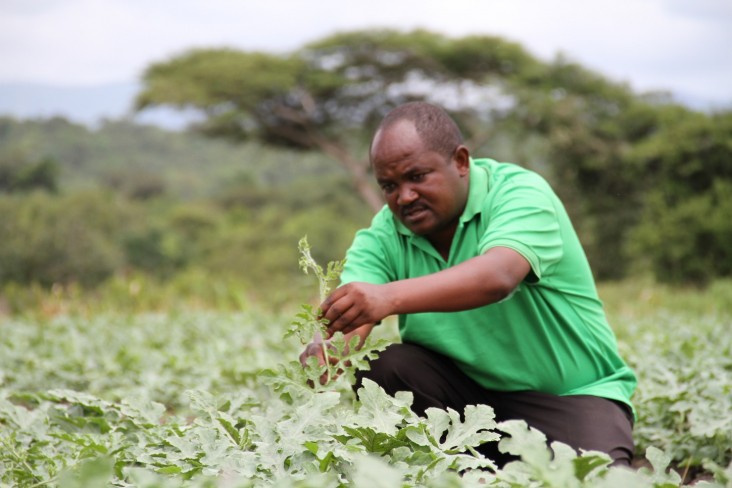
May 2015—Daniel Obare is a 45-year-old farmer from Ilaji village in the Mbeya region of Tanzania. Three years ago, he was a subsistence farmer, producing tomatoes and green peppers for his family’s consumption and selling the surplus on the side.
Obare used traditional farming methods—as many farmers in Tanzania do—to plant untreated seeds in sunken beds at random distances apart. These practices, along with the improper use of fertilizers and pesticides, reduce yields, leaving little for sale.
On the single acre where he grew tomatoes, Obare would spend up to $300 (600,000 Tanzanian shillings) to prepare the land, purchase seeds, hire labor and ensure irrigation each year. In some seasons, he would see no more than $400 in revenue. Without a substantial net profit for each round of production, it was no surprise that Obare never considered his farm a main source of income.
In September 2014, Obare visited the yearly farmer’s convention in Mbeya called the Nane Nane Fair. There he met members of the Tanzania Horticultural Association, an organization run by Tanzanians and supported by Feed the Future, the U.S. Government's global hunger and food security initiative led by USAID.
The association engages producers, processors, exporters, input suppliers and logistics handlers in the agriculture value chain and provides technical support to smallholder farmers by promoting good agricultural practices to boost production. Through USAID, Obare recognized these practices could improve his farm’s yields. He joined the association and learned the techniques applicable to his crops.
On his acre of tomatoes, Obare incorporated good agricultural practices such as raised beds, proper spacing, irrigation technology, improved varieties of seeds, and the proper use of fertilizers and pesticides. Within one production season, his revenue skyrocketed to just over $3,500. And with the additional installation of drip irrigation, Obare saves $100 dollars in production costs—a seemingly small but significant amount. He recalls collecting that amount in profits just a short time ago.
Obare now has 3 acres of land, and has diversified to cultivating watermelon. His good fortune has also extended past his business gains.
“My lifestyle has completely changed. For instance, my daughter, who was in a government school, has been transferred into a private school that has more facilities. I can confidently pay 1.5 million TZS [$740] for her annual school fees.”
Obare also plans to influence his neighbors by allocating part of his land as a demonstration plot and teaching others how to use improved technologies and good agricultural practices.
The success of Obare’s business is reflected in the growth of the Tanzania Horticultural Association. USAID’s contributions have enabled it to grow from a small collective to a major voice in the agriculture industry, reaching close to 13,000 farmers throughout Tanzania’s most populous farming regions in less than three years.
And future growth seems assured. In addition to technical support and market linkage services, the association is working closely with government authorities to create a business-enabling environment for the horticultural industry. Effectively linking small farmers with industry will accelerate economic growth, extending the gains of the agricultural sector to all Tanzanians.
LINKS
Follow @AmEmbTZ, on Facebook, on Flickr
Follow@FeedtheFuture, on Facebook, on YouTube







Comment
Make a general inquiry or suggest an improvement.